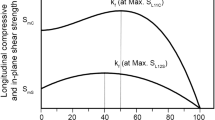Abstract
A closed-form solution using the actual distribution of the fiber aspect ratio is proposed for predicting the stiffness of aligned short fiber composite. The present model is the simplified form of Takao and Taya’s model and the extended version of Taya and Chou’s model, where Eshelby’s equivalent inclusion method modified for finite fiber volume fraction is employed. The validity of using average fiber aspect ratio for predicting the composite stiffness is justified in terms of the scatter of fiber aspect ratio, fiber volume fraction, and constituents‘ Young’s modulus ratio, comparing with the results by the present model. The guideline for selection of either the actual distribution or the average fiber aspect ratio is presented for the better prediction of the composite stiffness.
Similar content being viewed by others
References
Tandon G.P., Weng G.J. (1984). The effect of aspect ratio of inclusions on the elastic properties of unidirectionally aligned composites. Polymer Compos. 5: 327–333
Tucker C.L. III., Liang E. (1999). Stiffness predictions for unidirectional short-fiber composites: Review and evaluation. Compos. Sci. Technol. 59: 655–671
Wire S.L., Duckett R.A., Hine P.J., Ward I.M. (1999). Elastic property estimates of a unidirectional discontinuous fiber composite. Compos. Sci. Technol. 59: 113–122
Hsueh C.H. (2000). Young’s modulus of unidirectional discontinuous-fiber composites. Compos. Sci. Technol. 60: 2671–2680
Takao Y., Taya M. (1985). Thermal expansion coefficients and thermal stresses in an aligned short fiber composite with application to a short carbon fiber/aluminum. J. Appl. Mech. 52: 806–810
Chang J.S., Cheng C.H. (1995). Thermoelastic properties of short-coated fiber composites: Effects of length and orientation distribution. Compos. Sci. Technol. 55: 329–341
Hine P.J., Lusti H.R., Gusev A.A. (2002). Numerical simulation of the effects of volume fraction, aspect ratio and fiber length distribution on the elastic and thermoelastic properties of short fiber composites. Compos. Sci. Technol. 62: 1445–1453
Huang J.H. (2002). Some closed-form solutions for effective moduli of composites containing randomly oriented short fibers. Mat. Sci. Eng. A 315: 11–20
Lusti H.R., Hine P.J., Gusev A.A. (2002). Direct numerical predictions for the elastic and thermoelastic properties of short fiber composites. Compos. Sci. Technol. 62: 1927–1934
Taya M., Chou T.W. (1981). On two kinds of ellipsoidal inhomogeneities in an infinite elastic body: an application to a hybrid composite. Int. J. Solids Struct. 17: 553–563
Eshelby J.D. (1957). The determination of the elastic field of an ellipsoidal inclusion and related problems. Proc. R. Soc. Lond. A 241: 376–396
Mori T., Tanaka K. (1973). Average stress in the matrix and average elastic energy of materials with misfitting inclusions. Acta Metallurgica 21: 571–574
Author information
Authors and Affiliations
Corresponding author
Rights and permissions
About this article
Cite this article
Lee, JK. A study on validity of using average fiber aspect ratio for mechanical properties of aligned short fiber composites with different fiber aspect ratios. Arch Appl Mech 78, 1–9 (2008). https://doi.org/10.1007/s00419-007-0138-9
Received:
Accepted:
Published:
Issue Date:
DOI: https://doi.org/10.1007/s00419-007-0138-9



